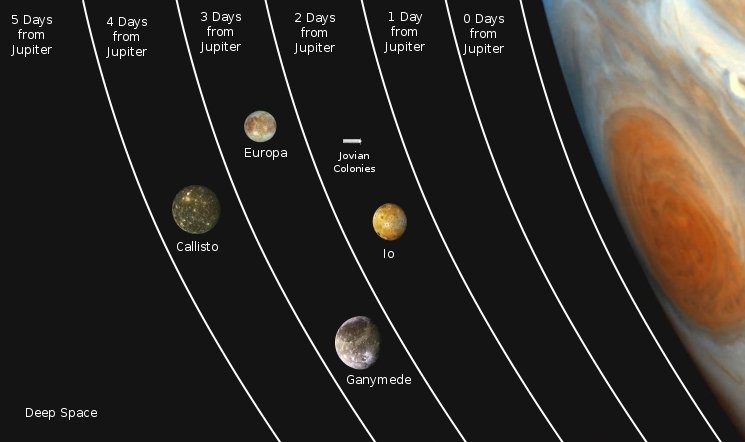
Map

|
The map of the Jupiter Sphere is divided into three types of area. Territories, Locations, and Compounds. Locations exist inside Territories, and Compounds can exist inside Locations or Territories. It is only possible to move from one area to an adjacent area. For example, Side 4 is a Location inside the Territory 2 days from Earth, and Texas Colony is a Compound in Side 4. It takes one move action to move from 2 days from Earth to Side 4, and then another action to move from Side 4 to Texas Colony. The reverse is also true. Clicking on the map above will toggle between the Jupiter map and the Asteroid Belt map. The Mars Sphere and Earth Sphere are linked seperately. Jupiter Sphere 0 days from Jupiter 1 day from Jupiter 2 days from Jupiter 3 days from Jupiter 4 days from Jupiter 5 days from Jupiter 0 days from Jupiter: High Jupiter Orbit, Low Jupiter Orbit 1 day from Jupiter: 2 days from Jupiter: Io, Jovian Colonies 3 days from Jupiter: Ganymede, Europa 4 days from Jupiter: Callisto 5 days from Jupiter: Deep Space Jupiter Orbit The Low Jupiter Orbit location operates a little differently from most locations. It can only be travelled to from High Jupiter Orbit, and vice versa. It is impossible to travel to Low Jupiter Orbit without a ship, although having travelled there with a ship some MS can fight there normally. Weather Low Jupiter Orbit is already a dangerous place, prone to violent gas storms. Sometimes however, the storms are more violent than usual. Weather for Low Jupiter Orbit will be determined once a week. Just because one location is experiencing bad conditions doesn't mean you will be caught in it, but it's better to be prepared than try your luck. Deep Space Finally, it's possible to go from 5 days from Jupiter to Mars, the Asteroid Belt or Earth if you are on a ship. This is not something you're expected to do regularly, so rules for this are listed on the message board. Low Jupiter Orbit: At the very edge of the gas clouds and storms of Jupiter, this area is where the Jupiter Collection Fleets harvest Helium 3. Gravity here is more intense than on Earth, and can have detrimental effects both on pilots and their mobile weapons. Only ships may travel freely here, and mobile suits that are not designed for a Jovian environment can only operate as stationary gun turrets. Combat here is extremely dangerous. MS fuel is eaten quickly trying to stay out of the gravity well, and freak storms can push huge amounts of dense atmosphere into a formation. High Jupiter Orbit: An orbital trajectory far from dangerous altitudes, spaceships and mobile weapons can travel here about as normally as they could in Earth Orbit. However, the gravitational pull on a mobile weapon is still strong in this zone, and mobile suits not designed for Jovian conditions will have some difficulty maneuvering here. Much like at lower altitudes, running out of fuel here can still be quickly fatal. Io: The second smallest of the Gallilean moons, Io is still much larger than Earths moon. With a thin and toxic atmosphere and a huge amount of active volcanic activity, it is not very hospitable to the prospect of colonization. Because of its short distance from Jupiter itself, it has a very fast orbital path, and stretches and distorts at certain points of its orbit. Jovian Colonies: Clustered around the asteroid fortress that serves as the diplomatic headquarters of the Jupiter Sphere, the Jovian Colonies are small in number, but their number is actually being increased, something that is not true for the sides in the Earth Sphere. Refugees from the war have been flocking to Jupiter, turning it from simply a corporate mining planet to something more. Europa: The smallest of the four Gallilean moons, Europa is covered by a thick layer of ice, under which there is a sea of flowing water. Much like Ganymede, Europa is used as a resource mining center for the JDEG, and there are future plans for colonization. While it has yet to be properly explored, it is rumored that there may be aquatic life in Europas ocean. Ganymede: The largest moon in the solar system and posessing a thin Oxygen atmosphere, Ganymede is the most hospitable place in the Jupiter sphere, although survival outside of a normal suit is still impossible. The JDEG is beginning plans to colonize the surface of Ganymede, their 131 year old Jovian culture now ready to properly populate the Jupiter Sphere. Callisto: The second largest of the Gallilean moons and the least active, Callisto is much like the Earths moon, a huge lifeless rock. While there are mining operations planned for Callisto, Ganymede is a much better candidate for colonization. Deep Space: The Earth Sphere is only so large. Interplanetary transport is not uncommon in the Universal Century, the farther away from the Earth Sphere you travel, the more it turns into an inhospitable frontier. Space becomes barren and cold, and travel without a well supplied ship is impossible. |